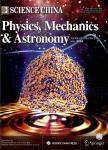Discovery of two rotational modulation periods from a young hierarchical triple system
作者机构:Center for Astronomy and Space SciencesChina Three Gorges UniversityYichang 443002China School of ScienceHangZhou Dianzi UniversityHangZhou 310018China Space Information Research InstituteHangzhou Dianzi UniversityHangZhou 310018China School of Physics and AstronomyChina West Normal UniversityNanChong 637002China Purple Mountain ObservatoryChinese Academy of SciencesNanjing 210023China National Astronomical ObservatoriesChinese Academy of SciencesBeijing 100101China University of Chinese Academy of SciencesBeijing 100049China
出 版 物:《中国科学:物理学、力学、天文学英文版》 (Science China: Physics, Mechanics & Astronomy)
年 卷 期:2023年第66卷第9期
页 面:179-189页
核心收录:
学科分类:07[理学] 070401[理学-天体物理] 0704[理学-天文学]
基 金:supported by the National Natural Science Foundation of China (Grant Nos. 11873034, U2031202, and 12203029) the Department of Science and Technology of Hubei Province for the Outstanding Youth Fund (Grant No. 2019CFA087) the Cultivation Project for LAMOST Scientific Payoff and Research Achievement of CAMS-CAS, and the science research grants from the China Manned Space Project (Grant No. CMSCSST-2021-A08) CSST Milky Way and Nearby Galaxies Survey on Dust and Extinction Project (Grant No. CMS-CSST-2021-A09) Funding for the TESS mission is provided by NASA’s Science Mission directorate
主 题:GW Ori pre-main sequence fundamental parameters triple stars
摘 要:GW Ori is a young hierarchical triple system located in λ Orionis, consisting of a binary(GW Ori A and B), a tertiary star(GW Ori C) and a rare circumtriple disk. Due to the limited data with poor accuracy, several short-period signals were detected in this system, but the values from diferent studies are not fully consistent. As one of the most successful transiting surveys, the transiting exoplanet survey satellite(TESS) provides an unprecedented opportunity to make a comprehensive periodic analysis of GW Ori. In this work we discover two significant modulation signals by analyzing the light curves of GW Ori s four observations from TESS, i.e.,(3.02 ± 0.15) and(1.92 ± 0.06) d, which are very likely to be the rotational periods caused by starspot modulation on the primary and secondary components, respectively. We calculate the inclinations of GW Ori A and B according to the two rotational periods. The results suggest that the rotational plane of GW Ori A and B and the orbital plane of the binary are almost coplanar. We also discuss the aperiodic features in the light curves;these may be related to unstable accretion. The light curves of GW Ori also include a third(possible) modulation signal with a period of(2.51±0.09) d, but the third is neither quite stable nor statistically significant.



